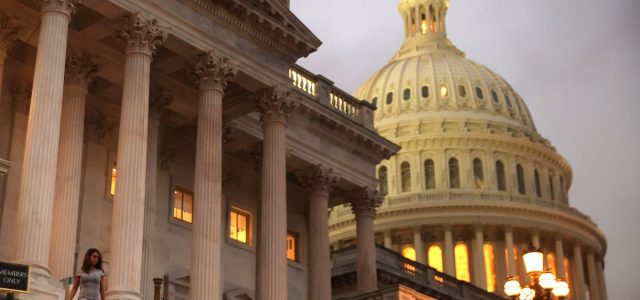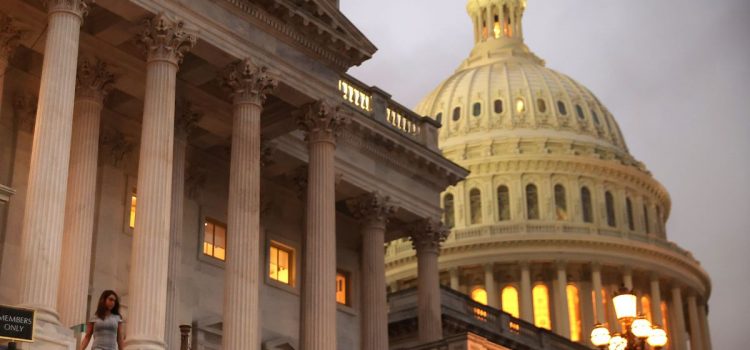



Democrats on Capitol Hill are still trying to work out a deal on infrastructure spending.
Chip Somodevilla/Getty Images
As Democrats in Congress wrestle over President Joe Biden’s multitrillion-dollar package targeting everything from roads to child care, hanging in the balance is a small but critical sliver of the infrastructure bill seen as a possible salve to our digital divide problem.
For more than two weeks, Democrats have been at an impasse over two bills at the center of Biden’s domestic agenda, leaving in limbo the fate of the $1.2 trillion bipartisan infrastructure bill that the Senate passed in August. This legislation provides long-overdue funding to upgrade traditional infrastructure, such as roads, bridges and electrical grids. But also included in the bill is a proposal for $65 billion in federal funding for broadband investment.
On one side of the debate are progressives in the House, led by Pramila Jayapal, a Democrat from Washington, who have been threatening to sink the legislation if a much larger “human infrastructure” bill — which includes money for child care, paid leave, universal pre-K, community college, affordable housing, Medicare expansion and climate action — is not passed via budget reconciliation in the Senate.
On the other side are two moderate Senate Democrats — Joe Manchin of West Virginia and Kyrsten Sinema of Arizona — who say the $3.5 trillion price tag is too hefty. House Speaker Nancy Pelosi of California postponed a vote on the bipartisan infrastructure bill in late September, setting a new deadline of Oct. 31 in the hopes the two sides can compromise.
Biden, who sees both pieces of legislation as essential to his Build Back Better domestic agenda, says it will happen.
“It doesn’t matter whether it’s in six minutes, six days or six weeks,” Biden said after Pelosi canceled a vote on the infrastructure bill in September. “We’re going to get it done.”
But broadband experts are bracing for the worst. Some fear that a stalemate that results in the House not voting on the bipartisan infrastructure bill will fritter away a once-in-a-generation opportunity to finally close the digital divide, an issue that has dogged policy makers for decades.
“I think we get one shot at this,” said Mark Buell, regional vice president, North America, of the Internet Society.
Legislative game of chicken
The bipartisan infrastructure bill includes a commitment of $42 billion to deploy broadband where it doesn’t yet exist. Where broadband is available, it promises another $14.2 billion to create a permanent $30-a-month-subsidy program to help low-income Americans afford service. The bill offers an additional $2.75 billion for digital equity and inclusion efforts, which could end digital redlining, the practice of internet service providers avoiding lower-income areas — typically neighborhoods with large populations of people of color — where they don’t think they’ll make money.
For the first time in more than two decades, policymakers see a real chance to make a difference.
“Out of crisis is opportunity,” FCC acting chair Jessica Rosenworcel said in an interview with CNET last month. “With this crisis, we’ve ended the days where we talk about broadband as a ‘nice-to-have.’ Policymakers everywhere now understand it’s a ‘need-to-have’ for everyone across this country.”
But all of that is at risk as progressives use the infrastructure bill as leverage to push for the Build Back Better Act, which has no Republican support.
Buell says this tactic may be risky. He noted it can be challenging to get significant spending legislation passed in a midterm election year. He also fears that as life starts to back toward normal in the US that leaders will lose the urgency to tackle the digital divide.
“We’re already seeing bipartisan agreement on anything start to wane,” he said. “The further we get from the darkest days of the pandemic, I’m afraid the less likely we’ll see significant commitment and cooperation between parties.”
Indeed, Blair Levin, now a Wall Street analyst but earlier a Federal Communications Commission official during the Clinton administration and the lead author of the National Broadband Plan under President Obama, acknowledged in a note to investors last month that the giant game of chicken playing out could, like the origins of World War I, drive a result that no one wants and that is bad for everyone in the economic realm.
The opportunity of a lifetime
What’s frustrating is that the issue has been around for more than a decade. In 2010, the Obama administration’s National Broadband Plan presented a guide for developing policy to crack the problem. But the report, published well after Congress had allocated stimulus money in the wake of the 2008 financial crisis, didn’t spur concerted action, Levin said.
“Ten years ago when we wrote the National Broadband Plan, we articulated many of the same things people are citing now,” he said. “But it wasn’t a priority. There wasn’t a lot of political capital. There also wasn’t any money left to tackle these issues.”
In 2017, the FCC estimated that it would cost $40 billion to deploy fiber networks to 98% of households. The agency said in 2021 that it has made some progress in ensuring more Americans are connected to broadband. From 2018 to 2019, the FCC said the number of Americans lacking at least a 25 megabit per second broadband connection dropped more than 20% to 14.5 million Americans.
Those left behind without access to reliable, affordable broadband are disproportionately people in communities of color, rural areas and low-income households. Pew Research Center data shows that 80% of white adults in the US report they have a broadband connection, while 71% of Black respondents say they have access to broadband and only 65% of Hispanics report having broadband.
In large rural and urban areas, high-speed internet access is simply nonexistent. In many other communities, service is often unreliable, unaffordable or too slow.
The COVID-19 pandemic made it clear that Americans need broadband to do everything from go to work to attend school to access health care. Congress committed billions in federal COVID relief dollars to provide subsidies to millions of Americans to keep them online.
Levin said the worldwide shutdown due to COVID is the driving force behind more investment to close the digital divide.
“COVID-19 was a better evangelist for why we need to solve this problem than I could ever be,” he said. “COVID taught lots of government officials why you need every school kid to have broadband in their homes and why rural areas need it for health care. There’s true bipartisan support now.”
Levin and other experts say that even if the broader infrastructure bill ends up without a House vote, efforts to solve the digital divide will not entirely die with it. He is hopeful that a separate bill could be carved out just to support broadband and closing the digital divide.
“There is so much bipartisan consensus on the need for getting more people online,” he said. “I think if a deal can’t be struck, there will be pressure on Democrats to do something with the broadband portion of the infrastructure bill.”
He added that Republicans would likely support it. “This is one of the most popular provisions of the infrastructure bill. I haven’t heard a single policy objection.” But, he said, “It’s not likely to happen quickly.”

